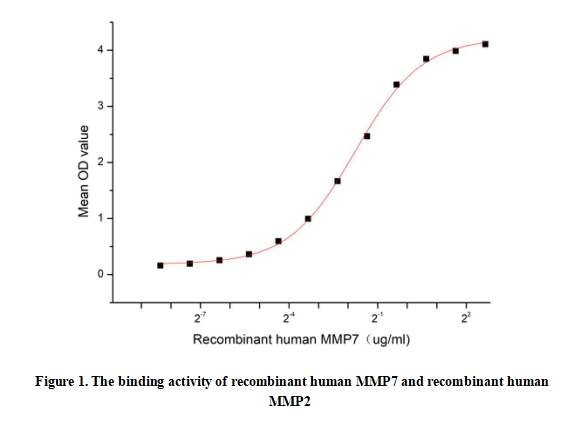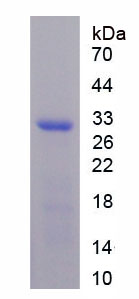Active Matrix Metalloproteinase 7 (MMP7)
MPSL1; MAT; PUMP-1; Matrilysin Uterine; Matrilysin; Matrin; Pump-1 Protease; Uterine Metalloproteinase
- Product No.APA102Hu61
- Organism SpeciesHomo sapiens (Human) Same name, Different species.
- Buffer Formulation20mM Tris, 150mM NaCl, pH8.0, containing 0.01% SKL, 5% Trehalose.
- Traits Freeze-dried powder
- Purity> 95%
- Isoelectric Point7.8
- ApplicationsCell culture; Activity Assays.
- DownloadInstruction Manual
- UOM 10µg50µg 200µg 1mg 5mg
- FOB
US$ 320
US$ 800
US$ 1600
US$ 4800
US$ 12000
For more details, please contact local distributors!
ACTIVITY TEST

Matrix Metalloproteinase 7 (MMP7) is a member of the matrix metalloproteinases (MMPs) family which are zinc and calcium dependent endopeptidases. Structurally, MMP-7 is the smallest of the MMPs and consists of two domains: a pro-domain that is cleaved upon activation and a catalytic domain containing the zinc-binding site. MMP-7 (matrilysin) is expressed in epithelial cells of normal and diseased tissues, and can degrade a variety of extracellular matrix substrates and other substrates and plays important regulatory roles in many human pathophysiological processes.Besides,Matrix Metalloproteinase 2 (MMP2) has been identified as an interactor of MMP7, thus a functional binding ELISA assay was conducted to detect the interaction of recombinant human MMP7 and recombinant human MMP2. Briefly, biotin-linked MMP7 were diluted serially in PBS, with 0.01% BSA (pH 7.4). Duplicate samples of 100μl were then transferred to MMP2-coated microtiter wells and incubated for 1h at 37℃. Wells were washed with PBST 3 times and incubation with Streptavidin-HRP for 30min, then wells were aspirated and washed 5 times. With the addition of substrate solution, wells were incubated 15-25 minutes at 37℃. Finally, add 50µl stop solution to the wells and read at 450nm immediately. The binding activity of MMP7 and MMP2 was shown in Figure 1, the EC50 for this effect is 0.30ug/mL.
USAGE
Reconstitute in ddH2O to a concentration of 0.1-0.2 mg/mL. Do not vortex.
STORAGE
Avoid repeated freeze/thaw cycles. Store at 2-8°C for one month. Aliquot and store at -80°C for 12 months.
STABILITY
The thermal stability is described by the loss rate. The loss rate was determined by accelerated thermal degradation test, that is, incubate the protein at 37°C for 48h, and no obvious degradation and precipitation were observed. The loss rate is less than 5% within the expiration date under appropriate storage condition.
GIVEAWAYS
INCREMENT SERVICES
-
 BCA Protein Quantification Kit
BCA Protein Quantification Kit
-
 Molecular Mass Marker for Protein
Molecular Mass Marker for Protein
-
 Monoclonal Antibody Customized Service
Monoclonal Antibody Customized Service
-
 Polyclonal Antibody Customized Service
Polyclonal Antibody Customized Service
-
 Protein Activity Test Experiment Service
Protein Activity Test Experiment Service
-
 Electrophoretic Mobility Shift Assay (EMSA) Experiment Service
Electrophoretic Mobility Shift Assay (EMSA) Experiment Service
-
 Buffer
Buffer
-
 Lentivirus Packaging Experiment Service
Lentivirus Packaging Experiment Service
-
 Adenovirus Packaging Experiment Service
Adenovirus Packaging Experiment Service
-
 Real Time PCR Experimental Service
Real Time PCR Experimental Service
-
 Spike RBD Protein (S-RBD)
Spike RBD Protein (S-RBD)
-
 Protein G
Protein G
-
 Protein A
Protein A
| Magazine | Citations |
| British Journal of Pharmacology | A novel, orally active LPA1 receptor antagonist inhibits lung fibrosis in the mouse bleomycin model PubMed: 20649573 |
| Neuroimmunomodulation | Upregulated Expression of Matrix Metalloproteinases and Tissue Inhibitors of Matrix Metalloproteinases in BALB/c Mouse Brain Challenged with Japanese Encephalitis Virus Pubmed: source |
| PLoS ONE | A Combinatorial Relative Mass Value Evaluation of Endogenous Bioactive Proteins in Three-Dimensional Cultured Nucleus Pulposus Cells of Herniated Intervertebral Discs: Identification of Potential Target Proteins for Gene Therapeutic Approaches Plosone: Source |
| Thromb Haemost. | Analysis of the expression of nine secreted matrix metalloproteinases and their endogenous inhibitors in the brain of mice subjected to ischaemic stroke Pubmed:24671655 |
| Histol Histopathol | Estrogen-deficient osteoporosis enhances the recruitment and activity of osteoclasts by breast cancer cells PubMed: 26254457 |
| VirusDisease | Circulating levels of matrix metalloproteinases and tissue inhibitors of matrix metalloproteinases during Japanese encephalitis virus infection Pubmed:26925446 |
| Am J Physiol Lung Cell Mol Physiol | Systematic phenotyping and correlation of biomarkers with lung function and histology in lung fibrosis Pubmed:26993522 |
| Cellular Physiology and Biochemistry | The MiR-495/Annexin A3/P53 Axis Inhibits the Invasion and EMT of Colorectal Cancer Cells pubmed:29224019 |
| s-space | Thyroid disrupting effects and associated mechanisms of TCPP in GH3 cell line and zebrafish (Danio rerio) larva and adult 10371/137708 |
| Science Translational Medicine | Large-scale proteomics identifies MMP-7 as a sentinel of epithelial injury and of biliary atresia. pubmed:29167395 |
| Hepatology | Diagnostic Accuracy of Serum Matrix Metalloproteinase‐7 for Biliary Atresia Pubmed: 30153340 |
| Journal of Pediatrics | Quantification of Serum Matrix Metallopeptide 7 Levels May Assist in the Diagnosis and Predict the Outcome for Patients with Biliary Atresia Pubmed: 30853207 |
| Pediatrics | Serum MMP-7 in the Diagnosis of Biliary Atresia Pubmed: 31604829 |
| Biomed Pharmacother | Human umbilical cord blood mononuclear cells protect against renal tubulointerstitial fibrosis in cisplatin-treated rats Pubmed: 31710895 |
| LABORATORY INVESTIGATION | The synthetic toxin biliatresone causes biliary atresia in mice Pubmed: 32681026 |
| diagnostics | Interstitial Score and Concentrations of IL-4R¦Á, PAR-2, and MMP-7 in Bronchoalveolar Lavage Fluid Could Be Useful Markers for Distinguishing Idiopathic Interstitial?¡ 33924683 |
| Cancer Cell Int | A novel strategy to identify candidate diagnostic and prognostic biomarkers for gastric cancer 34215253 |







